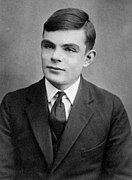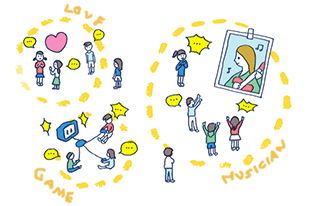[ Classification of Class Theory ]
1.Preparation
We classify Class Theories into four types by the reationship between Obj and Set.
First of all, I explain the axiom and the Atsumari which are often used
A.At ¬At B ⇒ (∀ b b∈B ⇒ ¬Obj b)
"¬At" means that an element which is not Obj exists,So this axiom says that Obj and ¬Obj are not mixed. It is Axiom of "Pureness" of element
A.Cl Cl k ⇒ (∀B B ma k ⇒ At B)
"Cl"-Class is made only by "At"-Atsumari. It is Axiom of "Pureness" of Atsumari.
A.{ } ¬Set y ∧ {y} ma k ⇒ ¬Set k
"¬Set" is a property which universal cllass u or Russel's class r have, so it means "Large". The axiom says that a Class which an Atsumari having one large Class makes is large
R Df. ∀b b∈R ⇔ Set b
Atsumari of Classes which don't have itself
U Df. ∀b b∈U ⇔ Obj b
Atsumari of Classes which are object of the Class Theory
r Df. R ma r
Class which R makes
u Df. U ma u
Class which U makes
Ordinary we use characters with suffix like "R_0" or "U_1" for constant of Atsumari, but if we don't mistake then we use characters without suffix like "R" or "U"
Set b Df. ¬(∃B b∈B ∧ B ma b)
Normal Classes have the property "Non self membership" so "Set" means "Normal"
Set_ob b Df. ¬(∃B At B ∧ b∈B ∧ B ma b)
Relatively Set based on Obj
Obj must be defined
T.Set_ob ∀b Set b ⇒ Set_ob b
R_ob Df. ∀b b∈R_ob ⇔ Set_ob b
The Atsumari of Classes which are not made by the At-Atsumari which has itself as a member
2. Classification
[ Type.1 ]
U ⊂ R
∀x Obj x ⇒ Set x
[ Type.2 ]
R ⊂ U
∀x Set x ⇒ Obj x
[ Type.3 ]
¬(U ⊂ R) ∧ ¬(R ⊂ U) ∧ ¬(U ∩ R =φ)
(∃x Obj x ∧ ¬Set x) ∧ (∃y Set y ∧ ¬
Obj y) ∧ (∃b Obj b ∧ Set b)
[ Type.4 ]
¬(U ⊂ R) ∧ ¬(R ⊂ U) ∧ (U ∩ R =φ)
(∃x Obj x ∧ ¬Set x) ∧ (∃y Set y ∧ ¬Obj y) ∧ ¬(∃b Obj b ∧ Set b)
The relationship of U and R of Type.1 and Type.2 is opposite
Type.3 is neither Type.1 nor Type .2 and U and R are overapped
Type.4 is neither Type.1 nor Type.2 and U and R are not overapped
"⊂" don't contain "="
Because if U=R is assumed then it becomes contradiction
If the following formula is assumed
∀b Obj b ⇔ Set b
U ma u and At U Hence
Cl u −*
The other hand
R ma r and ¬Set r 、 u=r Hence
¬Set u From assumption ¬Obj u
Also ∃B u∈B ∧ B ma u Hence
¬At B
From Axiom "A.Cl" and the formula "*"
At B
Contradiction
1.Preparation
We classify Class Theories into four types by the reationship between Obj and Set.
First of all, I explain the axiom and the Atsumari which are often used
A.At ¬At B ⇒ (∀ b b∈B ⇒ ¬Obj b)
"¬At" means that an element which is not Obj exists,So this axiom says that Obj and ¬Obj are not mixed. It is Axiom of "Pureness" of element
A.Cl Cl k ⇒ (∀B B ma k ⇒ At B)
"Cl"-Class is made only by "At"-Atsumari. It is Axiom of "Pureness" of Atsumari.
A.{ } ¬Set y ∧ {y} ma k ⇒ ¬Set k
"¬Set" is a property which universal cllass u or Russel's class r have, so it means "Large". The axiom says that a Class which an Atsumari having one large Class makes is large
R Df. ∀b b∈R ⇔ Set b
Atsumari of Classes which don't have itself
U Df. ∀b b∈U ⇔ Obj b
Atsumari of Classes which are object of the Class Theory
r Df. R ma r
Class which R makes
u Df. U ma u
Class which U makes
Ordinary we use characters with suffix like "R_0" or "U_1" for constant of Atsumari, but if we don't mistake then we use characters without suffix like "R" or "U"
Set b Df. ¬(∃B b∈B ∧ B ma b)
Normal Classes have the property "Non self membership" so "Set" means "Normal"
Set_ob b Df. ¬(∃B At B ∧ b∈B ∧ B ma b)
Relatively Set based on Obj
Obj must be defined
T.Set_ob ∀b Set b ⇒ Set_ob b
R_ob Df. ∀b b∈R_ob ⇔ Set_ob b
The Atsumari of Classes which are not made by the At-Atsumari which has itself as a member
2. Classification
[ Type.1 ]
U ⊂ R
∀x Obj x ⇒ Set x
[ Type.2 ]
R ⊂ U
∀x Set x ⇒ Obj x
[ Type.3 ]
¬(U ⊂ R) ∧ ¬(R ⊂ U) ∧ ¬(U ∩ R =φ)
(∃x Obj x ∧ ¬Set x) ∧ (∃y Set y ∧ ¬
Obj y) ∧ (∃b Obj b ∧ Set b)
[ Type.4 ]
¬(U ⊂ R) ∧ ¬(R ⊂ U) ∧ (U ∩ R =φ)
(∃x Obj x ∧ ¬Set x) ∧ (∃y Set y ∧ ¬Obj y) ∧ ¬(∃b Obj b ∧ Set b)
The relationship of U and R of Type.1 and Type.2 is opposite
Type.3 is neither Type.1 nor Type .2 and U and R are overapped
Type.4 is neither Type.1 nor Type.2 and U and R are not overapped
"⊂" don't contain "="
Because if U=R is assumed then it becomes contradiction
If the following formula is assumed
∀b Obj b ⇔ Set b
U ma u and At U Hence
Cl u −*
The other hand
R ma r and ¬Set r 、 u=r Hence
¬Set u From assumption ¬Obj u
Also ∃B u∈B ∧ B ma u Hence
¬At B
From Axiom "A.Cl" and the formula "*"
At B
Contradiction
|
|
|
|
|
|
|
|
「自由クラス理論」非標準集合論 更新情報
-
最新のイベント
-
まだ何もありません
-
-
最新のアンケート
-
まだ何もありません
-





